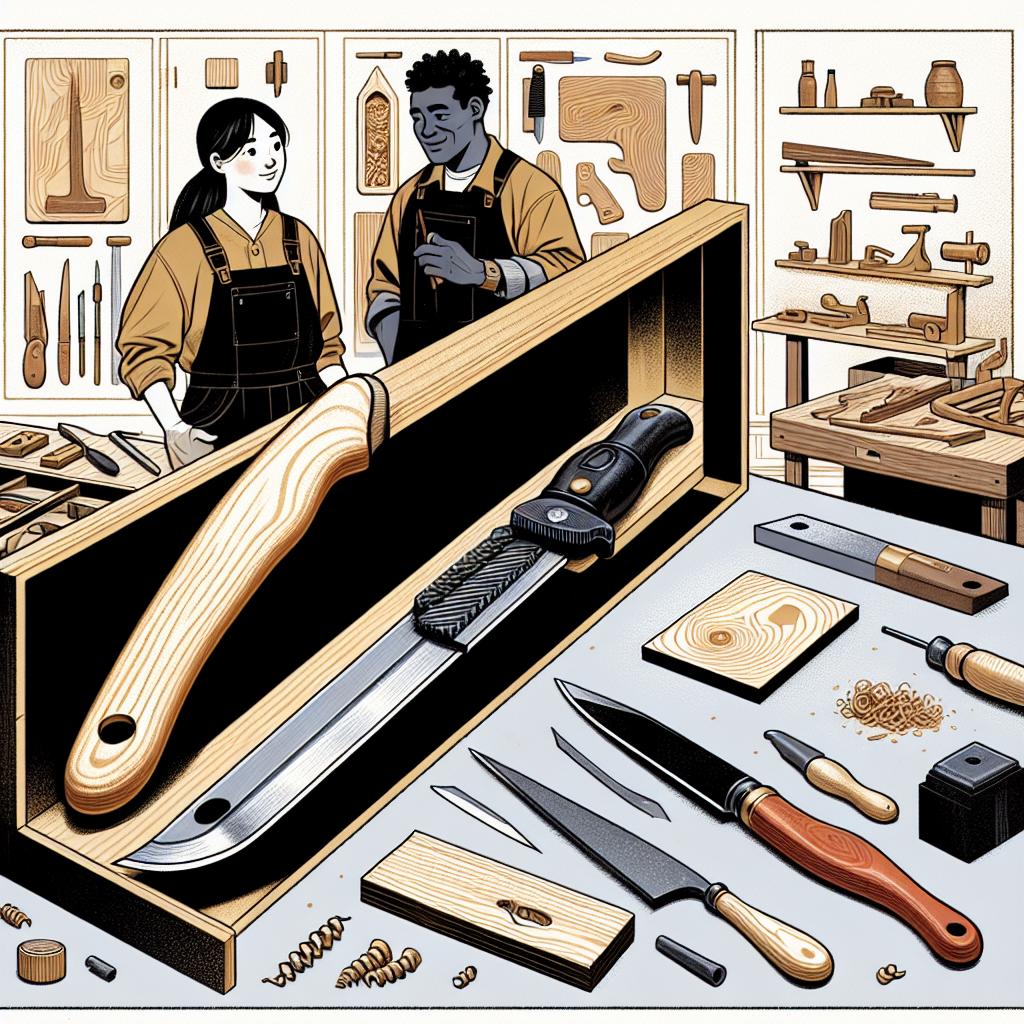Whether you’re a seasoned woodworker or just starting your journey into the world of hand tools, learning how to use a draw knife like a pro can elevate your craftsmanship to new heights. This versatile instrument, with its razor-sharp blade and simple design, is a powerful ally in shaping wood and achieving that perfect finish. In this article, we’ll delve into essential techniques that will not only boost your confidence but also enhance your skills as you harness the true potential of this age-old tool. Get ready to transform your projects as we explore the ins and outs of using a draw knife with precision and ease!
Welcome to your ultimate guide on How to Use a Draw Knife Like a Pro: Essential Techniques. Whether youre a seasoned woodworker or just starting your journey into crafting, mastering the draw knife can elevate your projects to new heights. This versatile tool not only offers precision and control but also connects you to the rich tradition of handcrafted artistry. In the following sections, well explore essential techniques that will sharpen your skills and transform your approach to woodworking, ensuring you wield your draw knife with confidence and finesse. Lets dive in!
With a draw knife in your hands, you open up a world of creative possibilities—it’s like wielding a wand that transforms raw timber into art. The beauty of this tool lies in its simplicity paired with endless potential. Think of it as the Swiss Army knife of woodworking: capable of shaping, smoothing, and carving various projects to perfection. If you’re ready to take the plunge (and maybe make a few shavings along the way), let’s dive into the essential techniques that will have you using this fantastic tool like a seasoned pro.
Understanding the Basics
Before you plunge into the exciting world of cutting and shaping, it’s worthwhile to get acquainted with the parts of the draw knife. The main body consists of a blade (typically 8-14 inches long) and two handles. You pull rather than push the knife, which gives you excellent control, akin to steering a kayak on a serene river. The pull motion requires a bit of finesse—here are key pointers:
- Grip it Right: Hold the handles firmly but not like you’re trying to crush a soda can. Your grip should be relaxed yet controlled.
- Blades and Angles: Maintain a consistent angle against the wood. Too steep, and you risk tearing; too shallow, and it’ll feel like trying to slice butter with a cold knife!
- Body Positioning: Keep your body aligned with the cut direction. You want to look like a graceful dancer—not a contorted pretzel!
Mastering the Stroke
The stroke is where the magic happens. It’s all about rhythm and flow. Like a musician playing their favorite tune, your draw knife stroke should be fluid and confident. Start with the following techniques:
- Initial Pass: Begin with shallow cuts to gauge how the wood responds. This is your warm-up; think of it as stretching before a run.
- Methodical Pulls: Use even pressure as you pull the knife towards you. Try to keep a steady pace, as if you’re jogging down a familiar trail.
- Adjusting Force: Increase the pressure gradually as the knife bites deeper, but avoid the temptation to muscle through. Your draw knife should feel like an extension of your hand, not a wrestling match!
Shaping and Refining
Once you’ve got your strokes down, it’s time to venture into shaping. Think of this as sculpting, where your wood becomes the canvas, and each pull reveals another layer of its character. As you refine your technique, consider these tips:
- Curved Cuts: To make graceful curves, tilt the draw knife slightly while pulling. It’s like guiding a dance partner through a twirl!
- Consistent Sound: Listen for the sound of the blade on the wood—your ears are there to help! A steady, rhythmic crunch means you’re in the sweet spot.
- Finish With Finesse: For that smooth, polished look, once you’ve shaped your piece, switch to a finer grit or a smoothing plane for the last pass. Trust me, it’s worth the extra effort!
Using a draw knife is not just about the mechanics; it’s a journey through the rich tapestry of woodworking. Each pull carries the whispers of artisans past, guiding you as you uncover the beauty in your wood. Remember, every project brings its own lessons—so keep your mind open, your blade sharp, and enjoy the ride!
Frequently asked questions
What is the best way to hold a draw knife for optimal control?
Holding a draw knife correctly is crucial for achieving precision and control during your woodworking projects. Start by gripping the handles firmly but not too tightly, as a relaxed grip allows for better movement and technique. Position your hands about shoulder-width apart on the handles; this influences the leverage you have over the blade. For most users, holding the draw knife at a slight angle to the wood surface improves control; experiment with angles between 10 and 30 degrees relative to the workpiece to find what feels most comfortable and efficient for you.
Another important aspect is your body positioning. Stand with your feet shoulder-width apart, and where possible, bend at the knees slightly for stability. This stance gives you a strong foundation to push and pull the draw knife effectively while maintaining balance. Ensure that your elbows are slightly bent and close to your body; this setup promotes a natural swing motion. Remember, you are using your body as much as your hands, so engaging your core can enhance stability and control as well.
What are the key techniques for using a draw knife effectively?
Using a draw knife effectively involves mastering a few key techniques. The primary movement is drawing the knife across the wood’s surface in a smooth, controlled motion. Start at one end of your workpiece and pull the knife towards you. It’s essential to maintain consistent pressure and angle during this motion to avoid gouging and uneven surfaces. If you find the cut is not as smooth as desired, check your angle and the sharpness of your blade. A dull blade can create more resistance, leading to greater effort and less control.
Another notable technique is the shaving technique, where you can adjust the amount of wood you remove by altering your draw angle. For instance, pulling the knife less steeply removes more wood, whereas a steeper angle will yield finer shavings. This is particularly useful when fine-tuning your workpiece or shaping edges. Practice consistently with varying angles and pressures to see how your results change—it is this iterative approach that will lead you to proficiency.
How do you maintain and sharpen a draw knife?
Proper maintenance and sharpening of your draw knife are vital for achieving the best results in your woodworking endeavors. Start by regularly cleaning the blade after each use to remove sap, dirt, or debris. A simple cloth can do the trick, but for stubborn residues, consider using a gentle wood cleaner that won’t damage the steel. Avoid submerging the knife in water or letting it soak, as this can cause rusting.
Sharpening is another key component; a sharp blade is essential for clean cuts and safer work conditions. Use a diamond sharpening stone or a fine whetstone, maintaining a consistent angle of about 25 to 30 degrees as you run the blade over the stone. It’s a good idea to apply water or oil to the stone to minimize friction and improve results. After sharpening, wipe down the blade and consider applying a thin coat of oil to protect it from moisture. Regular upkeep not only enhances performance but also extends the life of your tool.
Can you share tips for selecting the right draw knife for different projects?
Selecting the right draw knife for your specific project can greatly influence the outcome. Draw knives vary in size, blade width, and sharpness, so consider these factors based on your intended use. For larger projects, such as shaping logs or large boards, a wider blade (around 2 inches) may be preferable. This allows for broader strokes and can clear more material in fewer passes. Conversely, for finer detail work or smaller pieces, a narrow blade (about 1 inch) provides better control and finesse.
Another important aspect to consider is the material of the blade itself. High-carbon steel blades are popular due to their durability and ability to hold an edge; however, they can rust if not cared for properly. Stainless steel blades, while more resistant to rust, may require more frequent sharpening. handle design also plays a significant role. Choose a draw knife with comfortable, ergonomic handles that suit your grip style; this personal preference will make a notable difference in usability during long hours of work.
What safety precautions should I take while using a draw knife?
Using a draw knife, like any tool, requires a proactive approach to safety. Always ensure that your workspace is organized and free of any clutter that could lead to accidents. When using the knife, position your workpiece securely on a workbench or clamp to prevent movement while you’re cutting. Moreover, it’s crucial to maintain focus while using the tool—distraction can lead to slips, which can be dangerous given the sharpness of the blade.
Wearing appropriate personal protective equipment (PPE) can help mitigate risks. A good rule of thumb is to wear safety glasses to protect your eyes from flying debris. Steel-toed boots can protect your feet if a heavy object were to fall. Additionally, it’s wise to keep your hands and fingers clear of the knife’s path. Always cut away from your body, allowing for a more controlled motion and minimizing the risk of injury should the blade slip.
How can I maximize my efficiency when using a draw knife?
Maximizing efficiency while using a draw knife involves planning your project and techniques thoughtfully. Before starting, map out your design and identify the cuts you need to make. This way, you can minimize unnecessary movements and streamline your workflow. For instance, if you anticipate multiple passes in the same area, set up your workpiece in a stable position where you can comfortably access all sides.
Additionally, practice proper body mechanics. Engaging your core and using your arm strength effectively can lead to cleaner and quicker cuts. Maintain an ergonomic stance, shifting your weight naturally as you work; this reduces fatigue and maintains energy levels over longer sessions. Lastly, consider keeping a small notebook or log of your work to reflect on techniques and results. Recording what worked well and what didn’t can reveal patterns and areas for improvement in future projects, enhancing both your speed and skill over time.
Closing Remarks
mastering the art of using a draw knife is not just about wielding a tool; it’s about unlocking your potential as a craftsman. In our article, “How to Use a Draw Knife Like a Pro: Essential Techniques,” we’ve explored essential methods and pro tips that elevate your woodworking game. From proper grip techniques to understanding grain direction, you now have the knowledge to transform raw timber into stunning creations.
Remember, every expert was once a beginner—so don’t fret if your first projects don’t turn out perfect. Think of each practice session as one step closer to owning your craft, much like a rare vintage wine improves with age. So, grab that draw knife, channel your inner artisan, and let your creativity flow!
As you embark on this journey, don’t forget to have fun; after all, who said woodworking couldn’t come with a chuckle or two? Share your projects and progress with fellow woodworkers, and keep honing those skills. With patience and practice, you’ll soon be using a draw knife like a true pro. Happy carving!



